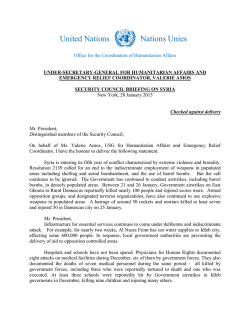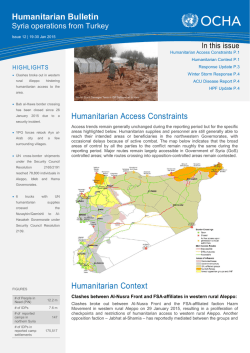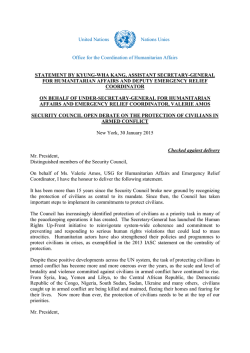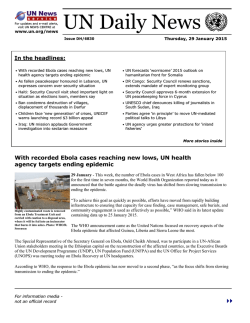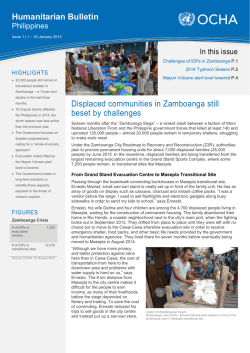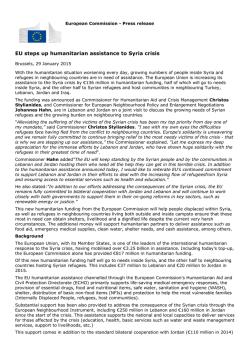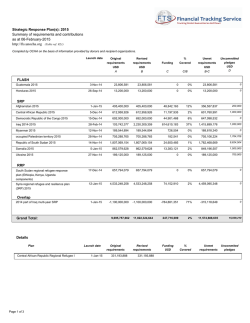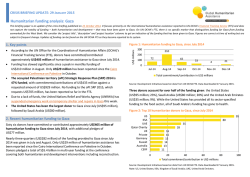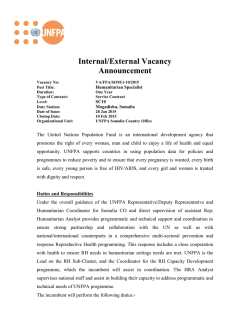
Download PDF
UKRAINE Situation report No.25 as of 30 January 2015 This report is produced by the United Nations Office for the Coordination of Humanitarian Affairs (OCHA) in collaboration with humanitarian partners. It covers 24 January 2015 – 30 January 2015, unless otherwise noted. The next report will be published on 6 February. Highlights Indiscriminate shelling continues to rage in the east of Ukraine. Some 30 casualties, including seven fatalities were recorded at a humanitarian distribution site in Donetsk. Freedom of movement in and out of conflict areas has been tightened as result of a Government of Ukraine temporary order. Civilians are trapped in conflict areas. Many are living in unhygienic, overcrowded, underground shelters with no WASH facilities, intermittent electricity in areas close to the frontline. An inter-agency mission visited Donetsk this week, to pave the way for a further step up the humanitarian response. 0.9 million IDPs 640,000 fled to other countries Situation Overview IDPs living for months in a row in underground shelters in the outskirts of Donetsk – photo: OCHA Fierce fighting and heavy, indiscriminate shelling in densely populated areas continue in different locations along the frontline in eastern Ukraine. The UN called for all parties to the conflict to spare civilians from unnecessary suffering, safeguard their lives from military engagement, and allow humanitarian partners to provide for their immediate needs. An immediate ceasefire ,especially in the Debaltseve and Horlivka areas, is urgently needed to enable civilians to leave if they want to, for humanitarians to assist affected communities, and to allow for the safe evacuation of the injured and of civilian population. The need for medicine, food, basic household items and shelter is rising by the day. As of 26 January, the Ministry of Social Policy (MoSP),the government entity officially in charge of IDP registration,has registered 942,748 IDPs across Ukraine, an increase of 21,108 since their last report on 21 January. The current system is unable to capture the movement of people in real time. Local authorities and partners agree that the discrepancy between the real and registered numbers of IDPs is a major issue hampering delivery of assistance. The practical solution identified is the establishment of a common database used by all involved, to ensure assistance is delivered and the risk for duplication minimized. This requires a strategic decision at the highest level of the Government, and adequate financial support for the initiative. Those civilians who continue fleeing Debaltseve, Avdievka, Uglegorsk, Krasnogorovka, Marinka and surroundings, are arriving with few belongings in Slavyansk and Kramatorsk. As an example, 600 civilians managed to leave Avdievka, in Donetsk oblast, but many more remain trapped in bomb shelters and basements with no facilities, intermittent electricity, and little or no food and WASH facilities. New collective centres are being opened by the oblast administration in government-controlled areas. The 21 collective centres reconstructed and equipped by an international organization reached 100 per cent of their capacity from slightly over 70 per cent at the beginning of the week. The five collective centres in Donetsk host about 3,000 people whose houses were destroyed. Many other civilians, including large numbers of elderly and children, are living in bomb shelters and basements in areas closer to the frontline since summer. A UN team visiting the area witnessed the unacceptable level of living conditions of some of these basement shelters: unhygienic, overcrowded and humid, with no WASH facilities, and intermittent electricity. Alternative solutions for these people who cannot return to their homes because of constant shelling must be found. Meanwhile, basic assistance will be provided through partners operating in the area. United Nations Office for the Coordination of Humanitarian Affairs (OCHA) Coordination Saves Lives | www.unocha.org Situation Report No. 25 – Ukraine | 2 Around 8,000 people remain without shelter in Petrovskiy, Kuibishevskiy and Kievskiy neighbourhoods of Donetsk city, where insecurity hampers access of humanitarian partners. The Mobile city collective centre opened in Kharkiv on 22 January, and by the 29 of the same month it was nearly at capacity. The Mayor’s office is managing arrivals. According to authorities, IDPs pay UAH 120 (US$7.5) per month to cover utility costs. Still in Kharkiv, the “Romashka” collective center - founded by local entrepreneurs has provided assistance to over 3,000 people in the past six months, with support from several humanitarian organizations and donors. Additional funding is required to expand operations. Two deadly incidents involving civilians occurred on 24 January in the city of Mariupol where at least 31 people (including two children) were killed and 108 (including nine children) were wounded following attacks by multiple launch rocket systems; and in Donetsk city, on 30 January, shells landed where a humanitarian organization was distributing humanitarian aid, killing seven and injuring some 20 people. The UN Human Rights Mission in Ukraine 1 (HRMU) and World Health Organization estimate that between mid-April 2014 and 29 January 2015, at least 5,244 people were killed and 11,862 were wounded in the conflict. Freedom of movement in and out of the conflict area has been tightened as result of the implementation of a Government of Ukraine (GoU) temporary order concerning travel in the conflict zone – whereby a complicated and unworkable pass system has been imposed - which entered into force on 21 January. Nonetheless, a UN interagency mission managed to cross the line of conflict without hindrances, utilizing identification documents provided by the organization. Humanitarian partners are advocating for a simplified system waiving bureaucratic requirements for humanitarian staff and cargo. The 21 January order has not been evenly applied, and risks the possibility for mismanagement of the pass system in place. The termination of state services in the territories controlled by the armed groups adds to the difficulties of providing the necessary documents to obtain GoU passes. GoU has indicated that movement of civilians in ‘danger areas’ will be facilitated. The UN team observed cues of civilians applying for passes at GoU checkpoints – locations that have been targeted in several occasions by shelling. In Kominternove municipality, located in ‘no man’s land’, 22 km from Mariupol, people cannot travel to their places of work or receive basic services as they are not allow to travel to Mariupol. Since the head of the local administration has left the village, no documents to cross lines can be issued, and the road towards the alternative location to get such documents is interrupted. No pensions or salaries have been paid for a long time, UXO contamination is a major issue and power and gas supply cuts are a fact of life. The village received some aid in December, but more is needed. Humanitarian partners are also engaging non-state actors in Donetsk who are finalizing processes requiring organizations to register with the de facto authorities. The UN mission in Donetsk highlighted the need to separate humanitarian issues/operations and political discussions, the civilian nature of humanitarian aid to which all humanitarian partners are committed, and advised against imposing bureaucratic impediments which would hamper the delivery of humanitarian aid. Non-state actors stated their commitment to facilitate humanitarian work. On 26 January 2015, the Cabinet of Ministers of Ukraine adopted the Order No 47-r, which established a regime of high alert and emergency in Donetsk and Luhansk region. This is not a state of emergency or martial law, which can only enacted by Parliament’s decision. The Government stressed that the decision is aimed at strengthening the coordination of activities of all authorities ‘so as to ensure the safety of citizens and civil protection of the population’. The introduction of this order is however expected to affect the provision of health care services within the regions. Findings of the inter-agency mission to Donetsk city confirmed that health authorities in the areas beyond government control are not receiving funding from central authorities and payments for city hospitals (drugs, salaries, foodstuff) were halted last summer. Centrally-run programs, including the treatment of several chronic diseases have come to a standstill and there is a critical lack of drugs across the non-government controlled areas. Many staff lack the resources to pay for transportation to reach medical facilities. Life-saving procedures for patients are unavailable as stocks are running out – putting many innocent civilian lives at risk. Lack of anaesthetics affects the ability of hospitals to perform surgery beyond critical emergencies. Funding Official reporting to the Strategic Response Plan for Ukraine (Dec 2014) indicate zero contribution to the humanitarian plan for 2015, despite information at local level whereby some limited contributions and pledges are 1 This is a conservative estimate of the based on available official data: casualties of the Ukrainian armed forces as reported by the Ukrainian authorities; 298 people from flight MH-17; and casualties reported by medical establishments of Donetsk and Luhansk regions: civilians and some members of the armed groups. United Nations Office for the Coordination of Humanitarian Affairs (OCHA) Coordination Saves Lives | www.unocha.org Situation Report No. 25 – Ukraine | 3 forthcoming. OCHA records all humanitarian contributions through its Financial Tracking Service (FTS). FTS aims to give donors due credit and visibility for their generosity, and helps track humanitarian funding and gaps in emergencies. Please register your contributions by emailing [email protected] or through the online contribution form at fts.unocha.org. On 27 January, three EU-chartered cargo planes carrying 85 metric tons of humanitarian supplies (tents, NFI, hygiene kits clothes) reached Ukraine. The EU Commissioner for Humanitarian Aid and Crisis Management, and the DG of ECHO, travelled to Dnepropetrovsk to receive the cargo, which will be distributed by humanitarian partners, including UNHCR and UNICEF. The Commissioner highlighted that this is a gesture of solidarity towards the people of Ukraine who suffer the consequence of the conflict, wherever they are or whichever party to the conflict controls the area where they are located. The European Commission has also announced a pledge of €15 million in humanitarian aid for Ukraine in 2015. The Government of the Russian Federation has advised OCHA that it would dispatch its twelve convoy of assistance to non-Government controlled Donbas on 31 January. The cargo reportedly includes humanitarian assistance (food and non-food items), medical supplied and fuel. The United Nations urges donors to make cash rather than in-kind donations, for maximum speed and flexibility, and to ensure the aid materials that are most needed are the ones delivered. Should in-kind contributions be contemplated in response to the crisis, please contact [email protected]. Humanitarian Response Livelihoods and Early Recovery (cluster lead: Inita Paulovica, [email protected]) Needs: Social institutions in Rovenky and Sverdlovsk have their public accounts blocked and cannot purchase coal Disruption of electric grids due to military activities in many communities, risk of collapse of heating systems. Response: 2,600 metric tons of coal provided to 78 social institutions and to 584 vulnerable residents in Rovenky and Sverdlovsk. Since 19 January, the private company DTEK has repaired and restored the electric supply in 130 settlements and prevented the collapse of the heating system in many cities. Gaps & Constraints: Increased insecurity hampers access, challenging operations. Education (cluster leads: Rudi Luchmann, [email protected]; Olena Sakovych [email protected]) Needs: Issues around exams in non-government-controlled areas (NGCAs) remain as all students attending the final year of secondary schools in NGCAs can receive state-format educational certificates only if they are registered at the nearest school in government-controlled area. On 24 January shells hit four schools in Mariupol. Pupils were relocated to neighboring schools. Response: Discussions are ongoing between the Education Cluster and the Ministry of Education and Science (MoES) regarding the exams of students in NGCAs. A UNICEF and Cluster Support mission to Ukraine in Severodonetsk and Slavyansk is assessing damages to schools and finalizing an agreement for renovation of these infrastructures. The MoES instructed local education authorities and school-masters to intensify the use of distance learning technologies in NGCAs. Gaps & Constraints: Escalating violence hampers access to education. Security and safety for pupils and their parents, risk involved in crossing the border to register at the nearest schools in government-controlled area. United Nations Office for the Coordination of Humanitarian Affairs (OCHA) Coordination Saves Lives | www.unocha.org Situation Report No. 25 – Ukraine | 4 Emergency Shelter and NFI (cluster lead: Igor Chantefor, [email protected]) Needs: Intensified, constant shelling in several locations along the conflict line triggered more displacement, and increased needs in the first line reception areas. Villages under constant shelling are cut off from electricity. There are also serious supply chain disruptions. The remaining population in cities where shelling is ongoing are living in underground shelters, in acute need of basic NFIs (blankets, bed linen, clothes, candles, heaters, fuel, etc.). Response: Some 642 HHs received cash grants from ADRA and IOM. Cash was distributed to some 16,200 HHs throughout the country since the beginning of the conflict. In Mariupol, UNHCR and SES provided humanitarian assistance to more than 1,000 individuals (blankets, bedding, clothes and plastic rolls) immediately after the 24 January shelling of the city. On 27 January, ECHO, in partnership with UNHCR provided 25 tons of plastic sheets, blankets and jerry cans in Severodonetsk and Mariupol. IOM has provided assistance to 724 IDPs in government-controlled areas. UNHCR distributed bedding and clothing NFIs for 750 IDPs in NGCAs of Donetsk city and Telmanove. Shelter Cluster started stockpiling close to the conflict area: blankets, cloth sets for adults and children, bedding kits. Gaps & Constraints: Access challenges to NGCAs due to damage of infrastructures (bridges, railway) and insecurity, compounded with increased bureaucratic impediments. Food Security and Nutrition (cluster leads: Sultan Mehmood, [email protected]; Valeriya Taran, [email protected]) Needs: Food needs (including baby food) continue to be among high priorities in both government-controlled and NGCAs of Lugansk and Donetsk oblasts. Inter-agency logistic endeavor – including humanitarian convoys – to deliver and preposition items in NGCAs. Response: WFP prepositioned 25,000 food parcels in Kharkiv and in areas north of Donetsk and Luhansk oblasts for around 25,000 people. WFP distributed around 6,380 food parcels and vouchers in Luhansk and Donetsk Oblasts, including for 1,000 newly arrived IDPs. From December 2014 – January 2015 RAF (Rinat Ahmetove Foundation) has distributed over 6,857 mt of food for 685,709 individuals in Donetsk. UNHCR distributed 475 kg of food in Mariupol following the 24 January shelling. WFP through its partners (PIN, ADRA and IRD) has enlisted warehouse locations in NGCAs. Gaps & Constraints: Access constraints. Food needs exceed available resources. More IDP data on new arrivals is needed for more accurate planning purposes. Health (cluster lead: Dr. Dorit Nitzan, [email protected]; Patricia Kormoss, [email protected]) Needs: Provision of specialized health care in Donbas area is unsustainable as most tertiary and specialized health care facilities with necessary equipment are situated in NGCAs. Health specialists have left these areas due to a halt in salary payments. TB, HIV and OST patients in NGCAs have an increasing need for medicines and diagnostic consumables. Due shelling this last week, hospitals in Debaltseve, Amvrosievka, Svitlodarsk and Slavianoserbsk are not operational. The hospital in Krasnoarmeisk has no water supply. Inconsistent electricity and water supply pose a risk of infectious diseases outbreak, while surveillance system and primary health services remains not fully functional. United Nations Office for the Coordination of Humanitarian Affairs (OCHA) Coordination Saves Lives | www.unocha.org Situation Report No. 25 – Ukraine | 5 Response: WHO provided Interagency Emergency Health Kits with medicines and consumables (20 Basic units, 1 Supplementary Unit and 1 Diarrheal kit) to Mariupol through the Ministry of Health. ICRC distributed medical supplies for trauma management to hospitals in Stanica Luhanska, Artemovsk, Kostantinovka, Dzerzhynsk, and Svitlodarsk. Gaps & Constraints: Humanitarian aid deliveries to NGCAs are restricted. A Government resolution that could allow for the securing of medicines for TB/HIV/OST care in terms of program activities of Global Fund recipients in the uncontrolled territories of Donetsk and Luhansk oblasts was not accepted for fast track approval by the Cabinet of Ministers. This may result in unacceptable delay of supply with consequent eminent danger of mass treatment interruptions. 7,700 of 16, 500 HIVinfected patients are on antiretroviral therapy (ART), about 2,300 TB patient, including about 500 people with MDR-TB are residing in NGCAs without consistent follow up and are at risk of treatment interruption by mid-February 2015. Since December 2014 the delivery of narcotic drugs for OST patients of Donetsk and Luhansk oblasts has been restricted, resulting in the discontinuation of treatment for more than 400 of 899 patients. More than 450 patients might be cut off from life-saving treatment if the stock of medicine is not filled by end of February. Lack of fuel in conflict areas results in a significantly decreased number of operational ambulances. Health specialists face major security concerns operating within the boundary line due to unpredictable shooting and present explosive remnants of war in the area. Protection (cluster co-leads: Ilija Todorovic, [email protected]; Fiona Frazer, [email protected]) – see also overview Needs: According to the Ministry of Social Policy, 3,900 elderly people remain in the institutional care in NGCAs. Approximately 7,000 elderly people continue to receive some social services at home. These institutions and services are no longer financed from the state budget and depend entirely on humanitarian aid. Medicine and hygiene kits are needed most. The total number of old persons in conflict-affected areas, who might require help as they were left alone, is unknown. Since the beginning of 2015, the quantity of requests concerning civil registration, including registration of the birth of children who were born in NGCAs, and concerning an exchange of such documents for documents of the Ukrainian sample significantly increased. Response: To harmonize the protection response for IDPs amongst the many community-based organizations and NGOs, on the ground trainings have been organized by UNHCR and its partners. Topics of such trainings have included effective cooperation with media; IDP human rights and protection; ethics in working in a war zone; and reduction of stigmatizing and discrimination of IDPs; use of correct international terminology in relation to IDPs. Gaps & Constraints: Issues around provision of banking services to Crimean IDPs remains unresolved as the State Migration Service need to confirm the residence of Crimean IDPs in government-controlled areas to unblock their accounts. Children who are with “guardians” – grandparents, uncles/aunts etc. but for whom there is no power of attorney from the parents for the de facto guardian to care for them removes opportunities for the children to receive benefits as IDPs. Uncoordinated “evacuation” of children from the GoU controlled areas of Donetsk and Luhansk. Some 39 children transferred last week – not clear if orphans or from families –were placed into institutions in Dnepropetrovsk. More children may be moved. UNICEF and Save the Children are monitoring the situation. Water, Sanitation and Hygiene (cluster lead: Rudi Luchmann, [email protected]) Needs: Nine locations in Severodonetsk (Kryakovka, Orehovo-Donetskoye, Krymskoye, Lopaskino, Lobachebo, Stanitsa Luganskaya, Olhobaya, Valuyskaya) have no access to drinking water due to damaged water supply amid recent shelling. Civilians are reportedly melting snow to collect water for drinking purposes. The Mayor of Volnovakha (Donetsk Oblast), requested assistance from the WASH partners as the city is experiencing a cut in water supply, as the pumping water system was damaged by shelling. The water shut-off United Nations Office for the Coordination of Humanitarian Affairs (OCHA) Coordination Saves Lives | www.unocha.org Situation Report No. 25 – Ukraine | 6 affects both the local population (23,500 inhabitants), and 1,500 IDPs in the city. Urgent requests have been issued for 5 kindergartens (500 children), 7 schools with 1500 pupils and 2 hospitals. Response: UNICEF is mobilizing bottled water for an immediate response in Volnovakha and other locations in Luhansk Oblast. UNICEF implementing partner Mama 86 continues to conduct hygiene promotion activities among 8,000 school children in Kharkiv, Donetsk, and Lugansk. Gaps & Constraints: Ongoing fighting in affected areas hinders the implementation of a comprehensive assessment of all damage to the water supply systems. Limited resources hamper the ability to address critical WASH needs. Coordination During the inter-agency mission to Donetsk this week, partners highlighted the need for strengthening coordination and information sharing among partners. A similar call has taken place by partners in Kharkiv. OCHA, in support of clusters, will gather detailed information about who-does-what-where, by activity, to support coordination, operational planning and assistance delivery as well as advocacy with parties to the conflict. This however requires the collaboration of all active partners and adequate coordination and information management capacity in all clusters. Strong and systematic monitoring of activities is required to ensure that intended – civilian - beneficiaries receive assistance. The Humanitarian Response website (http://www.humanitarianresponse.info/operations/ukraine) aims to strengthen information sharing among the humanitarian community in Ukraine and beyond. It is easy to navigate and provides useful overviews of contacts, events/meetings, key documents, maps and infographics, statistics and other operational data. Each cluster has a dedicated page to upload cluster-specific information. OCHA will populate the website over the coming weeks and welcome any suggestions your organization might have to improve layout and contents. Please click here for the meeting schedule. Background on the crisis In April 2014, armed groups in the Donbas region of eastern Ukraine (Donetsk and Luhansk) began to seize buildings and arms. As a result of ongoing fighting between armed groups and government forces, and of events in the Autonomous Republic of Crimea (ARC) in March 2014, people fled their homes and have become increasingly vulnerable as the conflict spread. Those in parts of Donbas affected by fighting, face imminent security threats due to military activities by all parties to the conflict that are increasingly concentrated in densely populated urban areas. Provision of basic services has been disrupted, supplies are increasingly limited, and an upsurge in lawlessness has occurred. Ongoing daily ceasefire violations continue to be reported, despite the 5 September Ceasefire and 19 September nine-point Memorandum agreed in Minsk. Indiscriminate shelling and continued insecurity are placing conflict-affected people and humanitarian actors at risk. For further information, please contact: Alexandra Eurdolian, Humanitarian Affairs Officer, Kyiv I [email protected] I +380 95 284 7322 Jake Morland, Desk Officer, New York I [email protected] I +1 212 963 2066 OCHA Ukraine Situation Reports are available at: http://reliefweb.int/country/ukr To be added or deleted from this situation report mailing list, please e-mail: [email protected], [email protected] United Nations Office for the Coordination of Humanitarian Affairs (OCHA) Coordination Saves Lives | www.unocha.org
© Copyright 2024
